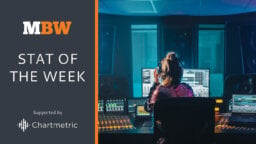MBW’s Stat Of The Week is a series in which we highlight a data point that deserves the attention of the global music industry. Stat Of the Week is supported by Cinq Music Group, a technology-driven record label, distribution, and rights management company.
At what point does a country become defined as a ‘mature’ music streaming market? It’s an increasingly essential question for the business to answer.
For one thing, the ‘maturity’ of certain markets is an excuse put forward as to why the streaming revenue growth of the worldwide industry is now, 12 years after Spotify launched, officially in decline. (And was before the current pandemic.)
For another thing, Spotify’s Daniel Ek has said that his company – which saw its own YoY streaming revenue growth fall in Q1 – will only consider increasing its subscription price in the world’s most “mature” markets.
Here’s Ek’s quote from SPOT’s Q1 2020 earnings call, when asked if Spotify had any plans to adjust its standard Premium price upwards in the coming months and years: “We have made small pricing experiments in some of our more mature markets… The response from those have been very positive, but it’s not something that we’re focusing on in the short term.”
Those “small pricing experiments” center on the Nordics and, more specifically, Norway.
In July 2018, Spotify said it was conducting a “test” by raising the price of a subscription in Norway by 10%, up to 109 NOK (circa $11.50) per month. Family and Student plans were raised by a similar proportion.
That “test”, as MBW suspected at the time, has actually become “not a test” – because those same price raises still apply today, two years on. And evidence suggests they’ve had no negative effect whatsoever on the lucrativeness of streaming subscriptions in the market.
Indeed, the IFPI‘s latest data shows that wholesale streaming subscription revenue in Norway (i.e. the money paid to record labels and artists) actually grew by $11.8m last year, a bigger jump than that seen in 2018 (+$4.5m) and in 2017 (also +$4.5m).
The crucial point: in 2019, subscription streaming revenue growth in the global music industry slowed down; yet, in Norway, a so-called ‘mature’ streaming market where Spotify raised its prices two years ago, subscription streaming growth more than doubled.
All of which points to the importance of our original question: At what point does a country become a ‘mature’ music streaming market?
Thanks to a recent YouGov poll of thousands of consumers in the Nordics, we have our answer.
MBW’s Stat Of The Week: According to YouGov, 49% of residents in the nordics are paying for a music streaming subscription. But 69% are users of a paid TV/movie streaming service.
YouGov’s research was based on a survey of over 4,000 consumers, of various ages and demographics, across Denmark, Sweden, Norway and Finland. The survey took place between December 27, 2019 and January 9, 2020 (i.e. a good chunk of time before COVID-19 became a global pandemic).
The data suggests that 49% of residents in these countries are now paying for a music streaming service.
In the birthplace of Spotify, Sweden, that number is at 52% (up on 51% in 2018) and in Norway – home of the Spotify price rise ‘test’ – it stands at 55% (up from 50% in 2018).

To flip that around, an estimated 45%, or 2.4m, of Norway’s 5.4m population still don’t pay for music streaming. And an estimated 51% of the circa 27m population of Scandinavia (in this case, Denmark, Sweden, Norway and Finland) – or 13.8m people – are currently not paying for a music streaming service.
Interestingly, the number of users of paid-for TV/movie services in the Nordics is significantly higher than those paying for streaming music platforms.
According to YouGov’s numbers, 69% of people in the Nordics currently subscribe to a paid for TV streaming platform (Netflix, HBO Nordic, Viaplay, C More, Amazon Prime).

Across the countries surveyed, with that approximate 27m cumulative population, this means that cira 18.6m people in the Nordics are paying for movie/TV streaming – over 5m more than the volume of people paying for music streaming (49%).
It’s worth mentioning that Spotify launched in the Nordics in 2008; Netflix didn’t come to Sweden until four years later.
Another interesting revelation from YouGov’s research: 91% of residents in the Nordics say they use streaming services (whether free or paid) to access music. Yet 75% of residents say they use YouTube to do so vs. 56% for Spotify.
You can read YouGov’s full survey (which also contains interesting Coronavirus-related data) through here, and we recommend that you do so.
It ultimately raises two very pertinent questions for the music business:
- (i) Does the industry lack the ambition of the movie/TV streaming business when it comes to chalking off key markets as ‘mature’ (i.e. ‘conquered’) in streaming terms? After all, more than half of all Scandinavians still aren’t actually paying for music streaming services;
- (ii) Why isn’t Spotify raising its prices in more territories outside Norway? Especially as its ARPU continues to tumble to worrying levels – and will do so even more thanks to its new ‘Duo’ tariff for couples?
On that second point, consider this: as we’ve mentioned, in Norway, subscription streaming revenue growth doubled in 2019, according to IFPI data, despite Spotify’s ongoing 10% price-raise for Premium.
Over in Sweden, though, where Spotify continues to cost the same as it has done for the past decade-plus (at 99 SEK per month for an individual account), it’s a different story.
According to IFPI data, the money paid to record labels and artists by subscription streaming platforms in Sweden in 2019 grew by $6.7m year-on-year; unlike Norway, this was slightly down on the streaming growth seen in 2018 (+$6.9m) and significantly down on 2017 ($8.8m).
So would a Spotify price rise in Sweden, just as it appears to have done in Norway, stimulate meaningful revenue increases for the music industry and its artists?
The CEO of IFPI Sweden, Ludvig Werner, certainly believes so. In an interview with Music Ally in April, Werner said: “Without a price increase in streaming services, I would guess we have a year or two [of growth left]. With a price increase… I think we can grow for another 10 years.”
He added: “Spotify launched with 1.5m songs; now we have 45m songs, podcasts, video. It’s not a music service any more. It is an entertainment platform, almost. And the prices are very, very low.”






